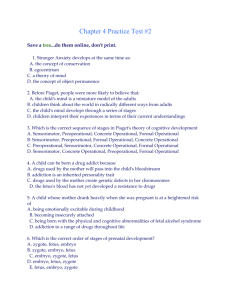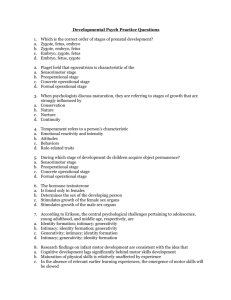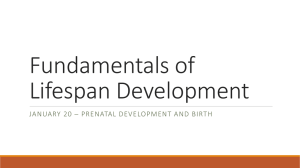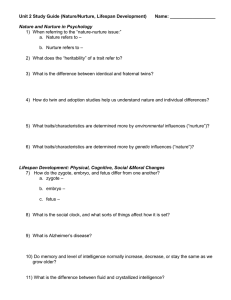Ch. 4 - Quia
advertisement
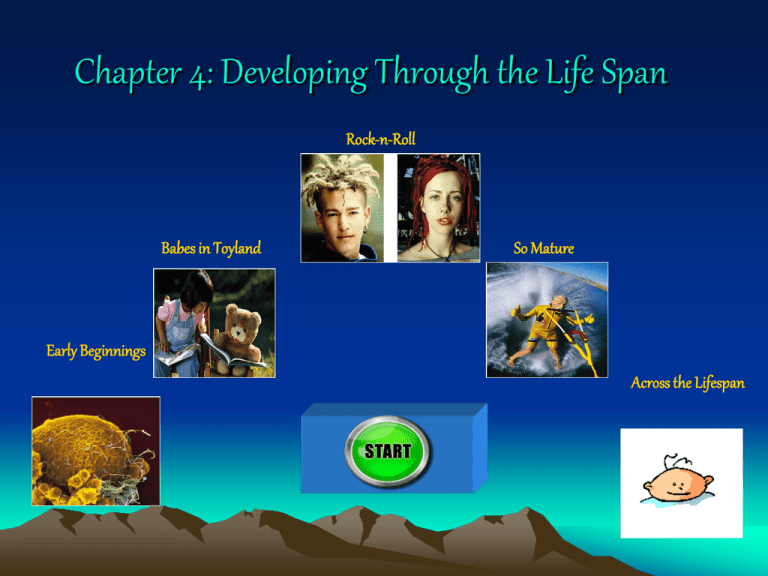
Chapter 4: Developing Through the Life Span Rock-n-Roll Babes in Toyland So Mature Early Beginnings Across the Lifespan 100 1. There are approximately ___ sperm deposited during intercourse. • • • • A) 200,000. B) 2 million. C) 20 million. D) 200 million. 2. The prenatal stage of development has three phases, in the order of: • • • • A) embryo, fetus, zygote. B) zygote, fetus, embryo. C) fertile, fetal, birth. D) zygote, embryo, fetus. 3. Teratogens are: • A) recessive genes that result in birth defects. • B) microorganisms that can cause mutations in normal development. • C) toxic agents which can cause defects in an embryo or fetus. • D) alleles that react negatively to the environment. 4. The leading cause of mental retardation is now: • • • • A) genetic abnormalities. B) malnutrition. C) Down Syndrome. D) fetal alcohol syndrome. 5. You have a pregnant friend who is having a glass of wine with dinner. She tells you that she is only having one glass. You tell her: • A) to be sure to limit it to one glass. • B) beer would be safer. • C) there is no safe level of alcohol when someone is pregnant. • D) as long as it is with food, it shouldn’t be a problem. 6. Touching a newborn’s cheek can trigger the ___ reflex, turning its head toward the source of touch and opening its mouth. • • • • A) sucking. B) rooting. C) grasping. D) nuzzling. 7. Newborns prefer to look at: • • • • A) a bull’s eye pattern. B) a human face. C) a circle. D) a shiny object. 8. As infants gain familiarity with repeated exposure to a visual stimulus, their interest wanes and they look away sooner. This is called: • • • • A) habituation. B) visual boredom. C) visual exhaustion. D) object permanence. 9. Psychologists who study physical, social and cognitive changes throughout the human life cycle are: • • • • A) child psychologists. B) developmental psychologists. C) clinical psychologists. D) cognitive-behavioral psychologists. 10. Timmy’s father covered up a toy with a towel. At age 4 months, Timmy did not look for it, but at 5 months, Timmy lifted the towel to get the toy. Timmy has developed: • • • • A) egocentrism. B) object permanence. C) accommodation. D) conservation. 11. Changes in height, weight, body hair, voice changes and in girls, breast development which happen in adolescence are known as: • • • • A) menarche. B) puberty. C) secondary sex characteristics. D) primary sex characteristics. 12. An adolescent’s occasional impulsive and immature behavior is at least partly a reflection of the last brain area to mature, the: • • • • A) frontal cortex. B) temporal lobes. C) sensory strip. D) parietal lobes. 13. According to Kohlberg’s theory of moral development, following the “letter of the law” is: • • • • A) called conventional morality. B) called postconventional morality. C) the highest level of morality. D) difficult for adolescents. 14. According to Erik Erikson’s Psychosocial Stages of Development, adolescence must deal with the psychosocial conflict of: • • • • A) intimacy vs. isolation. B) identity vs. role confusion. C) industry vs. inferiority. D) initiative vs. guilt. 15. Three areas of character education stressed for adolescents are: • A) responsible thinking, compassion, delayed gratification. • B) empathy, delayed gratification, service learning. • C) following rules, keeping quiet, helping others. • D) social harmony, communication, cleanliness. 16. Women’s foremost sign of biological aging is ___, which occurs around the age of ___. • • • • A) amenorrhea; 40 B) menarche; 45 C) puberty; 20 D) menopause; 50 17. During middle adulthood, the primary psychosocial task is to: • A) experiment with different roles. • B) review his or her life to find meaningfulness. • C) establish lasting and meaningful relationships. • D) contribute to future generations. 18. Which of the following is true: • A) Life satisfaction peaks at age 50 and then declines after 65. • B) Most people over 90 are senile. • C) Most women feel relief after going through menopause. • D) older people become more susceptible to short-term illnesses. 19. Underlying Alzheimer’s disease is loss off brain cells and deterioration of neurons that produce: • • • • A) endorphins B) acetylcholine C) serotonin D) dopamine 20. On which of the following tasks are 60-year-old adults most likely to outperform 20-year-old adults? • A) analogies. • B) solving an abstract geometry problem. • C) recalling previously presented nonsense syllables. • D) answering questions quickly. 21. The culturally defined preferred time for major life events, such as marriage, parenthood and retirement is known as: • • • • A) the life cycle. B) cultural dictates. C) the social clock. D) cultural dogma. 22. The difference between a 12-month-old child and most 18-month-old children when you put rouge on one cheek and place them in front of a mirror is: • • • • A) there is no difference. B) the 12 month old will think it is cute. C) the 18 month old will be less upset. D) the 18 month old will try to wipe it off. 23. Many couples cohabitate before marriage, believing this will ensure success when they marry. Statistics show: • A) they remain married longer. • B) they have less chance of being divorced. • C) this makes no difference. • D) they are at higher risk of divorce. 24: When children leave home, it creates a situation called, “the empty nest,” which effects most parents by: • A) increasing the risk of depression. • B) increasing the risk of divorce. • C) increasing the level of life satisfaction. • D) increasing work involvement. 25. Jamie does not steal a candy bar from the store because he is afraid his mother will spank him if he is caught. Jamie best represents a(n) _____ morality. • • • • A) preoperational B) preconventional C) conventional D) postconventional Stop here, or continue as a review 1. There are approximately ___ sperm deposited during intercourse. • • • • A) 200,000. B) 2 million. C) 20 million. D) 200 million. 139 2. The prenatal stage of development has three phases, in the order of: • • • • A) embryo, fetus, zygote. B) zygote, fetus, embryo. C) fertile, fetal, birth. D) zygote, embryo, fetus. 141 3. Teratogens are: • A) recessive genes that result in birth defects. • B) microorganisms that can cause mutations in normal development. • C) toxic agents which can cause defects in an embryo or fetus. • D) alleles that react negatively to the environment. 141 4. The leading cause of mental retardation is now: • • • • A) genetic abnormalities. B) malnutrition. C) Down Syndrome. D) fetal alcohol syndrome. 142 5. You have a pregnant friend who is having a glass of wine with dinner. She tells you that she is only having one glass. You tell her: • A) to be sure to limit it to one glass. • B) beer would be safer. • C) there is no safe level of alcohol when someone is pregnant. • D) as long as it is with food, it shouldn’t be a problem. 142 6. Touching a newborn’s cheek can trigger the ___ reflex, turning its head toward the source of touch and opening its mouth. • • • • A) sucking. B) rooting. C) grasping. D) nuzzling. 136 7. Newborns prefer to look at: • • • • A) a bull’s eye pattern. B) a human face. C) a circle. D) a shiny object. 143 8. As infants gain familiarity with repeated exposure to a visual stimulus, their interest wanes and they look away sooner. This is called: • • • • A) habituation. B) visual boredom. C) visual exhaustion. D) object permanence. 143 9. Psychologists who study physical, social and cognitive changes throughout the human life cycle are: • A) child psychologists. • B) developmental psychologists. • C) clinical psychologists. • D) cognitive-behavioral psychologists. 139 10. Timmy’s father covered up a toy with a towel. At age 4 months, Timmy did not look for it, but at 5 months, Timmy lifted the towel to get the toy. Timmy has developed: • • • • A) egocentrism. B) object permanence. C) accommodation. D) conservation. 149 11. Changes in height, weight, body hair, voice changes and in girls, breast development which happen in adolescence are known as: • • • • A) menarche. B) puberty. C) secondary sex characteristics. D) primary sex characteristics. 165 12. An adolescent’s occasional impulsive and immature behavior is at least partly a reflection of the last brain area to mature, the: • • • • A) frontal cortex. B) temporal lobes. C) sensory strip. D) parietal lobes. 167 13. According to Kohlberg’s theory of moral development, following the “letter of the law” is: • • • • A) called conventional morality. B) called postconventional morality. C) the highest level of morality. D) difficult for adolescents. 168 14. According to Erik Erikson’s Psychosocial Stages of Development, adolescence must deal with the psychosocial conflict of: • • • • A) intimacy vs. isolation. B) identity vs. role confusion. C) industry vs. inferiority. D) initiative vs. guilt. 170 15. Three areas of character education stressed for adolescents are: • A) responsible thinking, compassion, delayed gratification. • B) empathy, delayed gratification, service learning. • C) following rules, keeping quiet, helping others. • D) social harmony, communication, cleanliness. 166 16. Women’s foremost sign of biological aging is ___, which occurs around the age of ___. • • • • A) amenorrhea; 40 B) menarche; 45 C) puberty; 20 D) menopause; 50 176 17. During middle adulthood, the primary psychosocial task is to: • A) experiment with different roles. • B) review his or her life to find meaningfulness. • C) establish lasting and meaningful relationships. • D) contribute to future generations. 170 18. Which of the following is true: • A) Life satisfaction peaks at age 50 and then declines after 65. • B) Most people over 90 are senile. • C) Most women feel relief after going through menopause. • D) older people become more susceptible to short-term illnesses. 176 19. Underlying Alzheimer’s disease is loss off brain cells and deterioration of neurons that produce: • • • • A) endorphins. B) acetylcholine. C) serotonin. D) dopamine. 180 20. On which of the following tasks are 60-year-old adults most likely to outperform 20-year-old adults? • A) analogies. • B) solving an abstract geometry problem. • C) recalling previously presented nonsense syllables. • D) answering questions quickly. 184 21. The culturally defined preferred time for major life events, such as marriage, parenthood and retirement is known as: • • • • A) the life cycle. B) cultural dictates. C) the social clock. D) cultural dogma. 186 22. The difference between a 12-month-old child and most 18-month-old children when you put rouge on one cheek and place them in front of a mirror is: • • • • A) there is no difference. B) the 12 month old will think it is cute. C) the 18 month old will be less upset. D) the 18 month old will try to wipe it off. 161 23. Many couples cohabitate before marriage, believing this will ensure success when they marry. Statistics show: • A) they remain married longer. • B) they have less chance of being divorced. • C) this makes no difference. • D) they are at higher risk of divorce. 187 24: When children leave home, it creates a situation called, “the empty nest,” which effects most parents by: • A) increasing the risk of depression. • B) increasing the risk of divorce. • C) increasing the level of life satisfaction. • D) increasing work involvement. 188 25. Jamie does not steal a candy bar from the store because he is afraid his mother will spank him if he is caught. Jamie best represents a(n) _____ morality. • • • • A) preoperational B) preconventional C) conventional D) postconventional 168 Answers 1. D 9. B 17. D 2. D 10. B 18. C 3. C 11. C 19. B 4. D 12. A 20. A 5. C 13. A 21. C 6. B 14. B 22. D 7. B 15. B 23. D 8. A 16. D 24. C 25. B
